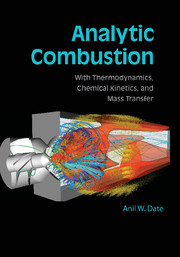Book contents
- Frontmatter
- Contents
- Preface
- Symbols and Acronyms
- 1 Introduction
- 2 Thermodynamics of a Pure Substance
- 3 Thermodynamics of Gaseous Mixtures
- 4 Chemical Equilibrium
- 5 Chemical Kinetics
- 6 Derivation of Transport Equations
- 7 Thermochemical Reactors
- 8 Premixed Flames
- 9 Diffusion Flames
- 10 Combustion of Particles and Droplets
- 11 Combustion Applications
- APPENDIX A Thermochemistry Data
- APPENDIX B Curve-Fit Coefficients for Δhc, Tad, Kp, Cp, h, and s
- APPENDIX C Properties of Fuels
- APPENDIX D Thermophysical and Transport Properties of Gases
- APPENDIX E Atmospheric Data
- APPENDIX F Binary Diffusion Coefficients at 1 atm and T = 300K
- Bibliography
- Index
6 - Derivation of Transport Equations
- Frontmatter
- Contents
- Preface
- Symbols and Acronyms
- 1 Introduction
- 2 Thermodynamics of a Pure Substance
- 3 Thermodynamics of Gaseous Mixtures
- 4 Chemical Equilibrium
- 5 Chemical Kinetics
- 6 Derivation of Transport Equations
- 7 Thermochemical Reactors
- 8 Premixed Flames
- 9 Diffusion Flames
- 10 Combustion of Particles and Droplets
- 11 Combustion Applications
- APPENDIX A Thermochemistry Data
- APPENDIX B Curve-Fit Coefficients for Δhc, Tad, Kp, Cp, h, and s
- APPENDIX C Properties of Fuels
- APPENDIX D Thermophysical and Transport Properties of Gases
- APPENDIX E Atmospheric Data
- APPENDIX F Binary Diffusion Coefficients at 1 atm and T = 300K
- Bibliography
- Index
Summary
Introduction
Our interest now is to study chemical reactions in the presence of fluid motion so that fluid mixing effects can be incorporated in the determination of the product composition. In the study of transport phenomena in moving fluids, the fundamental laws of motion (conservation of mass and Newton's second law) and energy (first law of thermodynamics) are applied to an elemental fluid known as the control volume (CV).
The CV may be defined as an imaginary region in space, across the boundaries of which matter, energy, and momentum may flow. It is a region within which a source or a sink of the same quantities may prevail. Further, it is a region on which external forces may act.
In general, a CV may be large or infinitesimally small. However, consistent with the idea of a differential in a continuum, an infinitesimally small CV is considered. Thus, when the laws are to be expressed through differential equations, the CV is located within a moving fluid. In the Eulerian approach, the CV is assumed fixed in space and the fluid is assumed to flow through and around the CV. The advantage of this approach is that any measurements made using stationary instruments (velocity, temperature, mass fraction, etc.) can be compared directly with the solutions of differential equations.
- Type
- Chapter
- Information
- Analytic CombustionWith Thermodynamics, Chemical Kinetics and Mass Transfer, pp. 112 - 133Publisher: Cambridge University PressPrint publication year: 2011



